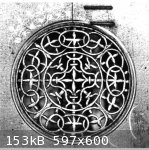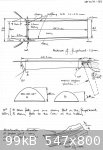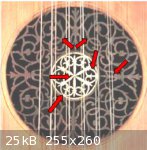
jdowning - 10-15-2010 at 12:39 PM
30 years ago - courtesy of curator James Hunter - I had the opportunity to examine and measure all of the early lutes and guitars, part of the
important Charles van Raalte collection of early musical instruments, housed in the Dean Castle museum, Kilmarnock, Scotland. I had intended to make
full scale working drawings of the instruments but shortly after completing drawings of two of the lutes my work as a professional engineer took me to
another country and culture - never to return - and so the project was left uncompleted. However, I still have my notes, full scale tracings of the
instrument profiles as well as some photographs given to me by the museum to work with.
One instrument that was not on display is a 'guitar-lute' - a well executed 19th C conversion of a 16th C ivory bodied lute by renowned lute maker
Marx Unverdorben. Only three other examples of lutes by this maker are known to have survived.
Unverdorben was a German luthier working in Venice around the middle of the 16th C.
It is possible that the original lute, over a period of 400 years or so, has experienced at least three modifications :
1) the original 6 (double) course lute.
2) modified in the 18th C to a 6 (single) course 'gallichon' lute - popular in the late 'baroque' period in Germany.
3) modified to a 'lute-guitar' some time during the
19th C in Germany.
Although the instrument originally was a lute - not an oud - in its present state it has some original features that appear to be oud like -
suggesting that Unverdorben (and other of his contemporaries) may - in his time - have been influenced by earlier oud making traditions.
The ivory bowl shows signs of great age and is likely to be original - although one has always to suspect maker's labels. This one simply states "Marx
unverdorben in Venetia" (but no date) in printed script that is correct, in style, for the time period.
An unusual feature of the bowl is the applied 'arabesque' design in gold leaf - with green and red highlights - on each of the ribs . Although now
well worn over time, as a decorative feature it is still visually impressive. I am not aware of other surviving historical lutes with this rather
impractical decorative feature but it is a device often seen in ouds as wooden rib inlay work.
Otherwise the geometry of the bowl - with its slightly flattened section - is appropriate for a mid 16th C. Venetian lute.
The neck is very narrow for a 19th C guitar so may be original. The 19th C style guitar pegbox has been spliced into the neck that once had a lute
style pegbox (see my manuscript notes to follow). The length of the neck is sufficient for eight frets.
The sound board and sound hole edge has fragments of applied 'arabesque' gold decoration. The carved rosette is inset (oud like - unlike the 'cut in'
rosettes of most surviving lutes). The sound hole diameter is 1/3 the width of the bowl at the sound hole transverse centreline - typical of early
lute design practice dating to the 15th C (Arnault de Zwolle).
It can not be determined if the soundboard is original (possibly not?) or a replica of the original.
Perhaps the geometry of the instrument will reveal some answers? An analysis will be reported in ' Old Oud compared to Old Lute Geometry ' on this
forum.
The attached images are the museum archive photos of the instrument. My notes to follow.





jdowning - 10-16-2010 at 05:34 AM
..... and here, for information, some of my notes and sketches relating to this instrument. The following observations may be relevant:
1)The neck of the instrument has pulled up about 5 mm over time and is twisted due perhaps to excessive string tension after being converted to a
guitar.
A dip in the sound board measuring about 6.5 mm from level at a point just below the sound hole was - at the time - taken to be another distortion due
to excessive string tension. If this was a distortion, then as a consequence the edges of the bowl might be assumed to have opened out. However, this
significant sound board dip is a feature found in other surviving lutes as well as in some old ouds (Manol and Nahat for example) and is now
considered not to be a distortion but a deliberate attempt by the luthier (by scooping out the edges of the bowl at its widest point) to prevent
contact of the strings over the sound hole area with the sound board under full tension. As will be seen later, the instrument profile in its present
state conforms closely to one based upon a 3:4:5 right triangle geometry - further suggesting that there has been no significant distortion of the
edges of the bowl as first thought.
2) It is not possible to determine if the sound board is original or was added as part of the guitar conversion. There are no traces or marks of an
earlier bridge. However, any traces might be hidden by the 19th C guitar bridge - a possibility suggested by the instrument geometry. So although the
sound board may not be original (dating to the 16th C) it could be a replacement made some time prior to the 19th C when the instrument was still a
lute.
3)The neck, prior to the 19th C, was originally made to accept a bent back lute style pegbox - the 19th C guitar pegbox simply being cut to fit the
original pegbox to neck joint.
4) The fingerboard typical lute style with terminal 'stings' extending onto the sound board the ends of the 'stings' marking the inside edge of the
neck block (as does the 'beard' decoration of an oud). Originally without frets, fixed metal and wooden frets were added to the fingerboard as part of
the 19th C guitar conversion.
It is not possible to determine when the lute was converted to a guitar - most likely during the early 19th C in Germany when nostalgia for Germany's
Mediaeval past (days of the Holy Roman Empire) captured the nation's imagination. As lute playing traditions had by then been lost, old lutes were
simply converted to guitars in order to play their romantic part in the performance of old German folk songs. Towards the end of the 19th century this
style of instrument became popular among a national youth movement (Wandervogel) and were made in great number during the first part of the 20th C. I
remember seeing them for sale in music shops in Britain even as late as 1960.
For the geometrical analysis see 'Old Oud compared to Old Lute Geometry'





jdowning - 10-17-2010 at 11:15 AM
Many surviving lutes have rosettes 'cut in' to the sound board with designs that obviously have Arabic origins and some that may have been directly
copied from ouds of the 16th C - we will never know. As a lute rosette design is cut directly into the sound board wood the same level of fine detail
is not possible compared to a 'set in' oud rosette made from fine grained hardwood, bone or ivory.
The rosette on the Dean castle Unverdorben lute is unusual in that it is set into the sound board like an oud rosette as well as having features that
can be found in some of the old oud rosettes.
For example, making comparisons with a rosette on an 1889 Abdo George Nahat oud (posted on the forum a couple of years ago by corridoio). The rosette
has an inner circle with a 'spoked wheel' design at the centre as well as a similar inverted leaf motif. This style of 'vase shaped' leaf motif is
also repeated outside the inner ring on the Nahat rosette. The main design of the Nahat rosette is a repeated vine like 'Arabesque' each terminating
in a leaf. Clearly, the lute rosette follows the same pattern (although the workmanship is not so fine).
The Nahats likely incorporated traditional design elements in their rosettes so this comparison may suggest that the lute maker copied an early oud
rosette for the pattern (no - not a Nahat but from a much earlier oud!)
The inner ring motif is less commonly found in old lute rosettes. Here are a couple of other examples in my files - both by German luthiers working in
northern Italy during the 16th C.


